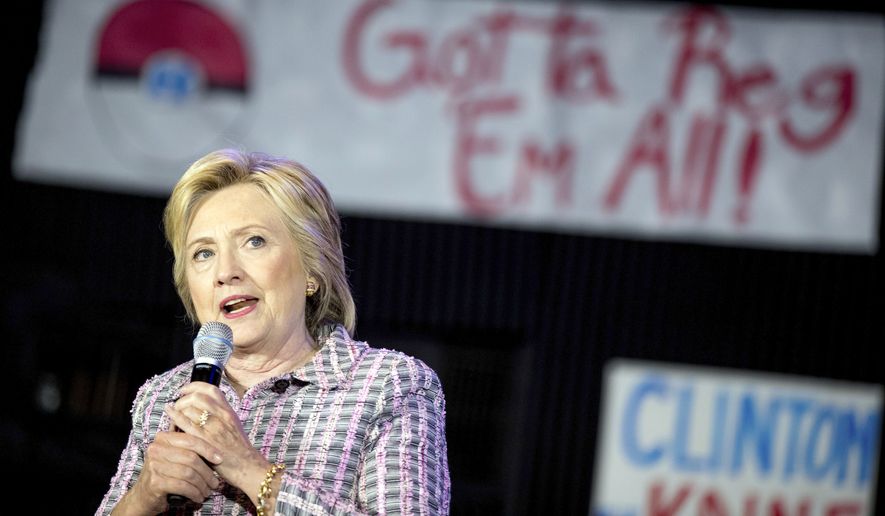OPINION:
Hillary Clinton handed Donald Trump the best campaign issue he could hope for this week, and he ignored it.
While Mrs. Clinton was proposing a huge increase in capital gains taxes on investors that would kill jobs and what little is left of the chronically weak Obama economy, Mr. Trump was urging his buddy, Russian thug Vladimir Putin, to step up his cyberwar on the United States to find Hillary’s 30,000 deleted emails.
Worse, Mr. Trump didn’t respond negatively when a reporter asked him if he would recognize Mr. Putin’s military seizure of Ukraine’s Crimean peninsula as Russian territory. Or whether he would lift U.S. sanctions against Moscow for its act of war on a sovereign country.
“We’ll be looking at that. Yeah, we’ll be looking,” Mr. Trump responded at a news conference Wednesday.
Mr. Putin’s military takeover of Crimea in 2014 was the first time since World War II that a European nation has seized territory from another country in the region. He is now said to be looking at the Baltic states as his next victim.
While Mr. Trump was clumsily sidestepping questions that might offend his pal in the Kremlin, Hillary Clinton was calling for punishing tax hikes that economists said would kill job-creating capital investment in a stalled economy.
Hillary’s tax hike plan would push the top capital gains rate up to 36 percent for people and businesses who hold investments for a minimum of two years but less than six years.
She says this would raise taxes just on the rich, while discouraging short-term investments by major investors.
In a slowing economy that was barely growing at less than 1 percent, and now suffers from declining capital investment for new business start-ups, her plan is the kiss of death.
The history of capital gains taxes can be summed up in one sentence: Lower tax rates result in stronger economic growth, more jobs, and more tax revenue that will reduce the budget deficit.
Hillary should know this better than anyone, because her husband, President Clinton, signed a Republican cap-gains tax cut bill in his second term that led to a wave of new investment in high technology, good paying jobs and stronger GDP growth.
He began his presidency by raising the top two income tax rates to 36 percent and 39.6 percent, and raised the corporate tax rate to 35 percent.
Economic growth limped along at no better than 3 percent (something President Obama has never achieved), and the American people saw little or no improvements in the U.S. economy. In the 1994 elections, the GOP gained 54 seats in the House and 8 seats in the Senate.
In 1995, Bill Clinton told a party fundraiser that he had made a bad mistake. “Probably there are people in this room still mad at me at that budget because you think I raised your taxes too much. It might surprise you to know that I think I raised them too much, too,” he said.
In his second term, he quickly signed the GOP’s welfare reform plan, slashed trade tariffs under the North American Free Trade Agreement (NAFTA) to boost trade, and sharply cut the capital gains tax to 20 percent from 28 percent
The result was a boom in capital investment, stronger employment growth, 4.2 percent economic growth, much higher wages, and a sharp rise in worker 401(k) retirement funds as the stock market soared.
All of this happened “not by raising tax rates on high income but not yet rich middle-class families, and certainly not by raising the capital gains tax nor by massively increasing federal spending,” economic analyst Charles Kadlec wrote in Forbes magazine.
Instead, he said, “it was a prosperity produced by freeing America’s poor from a punitive welfare system, lowering tariffs, reducing tax rates on the creators of wealth, [and] limiting the growth of federal expenditures.”
We can dramatically turn the economy around with the same policies, he adds. “But to do so, the American people will have to overcome the envy feeding myth perpetrated by President Barack Obama and the spin-masters and leadership of the Democratic Party that raising taxes on high incomes will somehow lead to more job creation, more opportunity and increased prosperity and security for the middle-class.”
Unfortunately, America’s voters are faced with two candidates from opposing parties who are running flat out on raising taxes, in one way or another, on Mr. Obama’s bedridden economy.
Hillary, who opposed many of her husband’s actions on trade, welfare and tax cuts, is planning to raise business investment tax rates, oppose all free trade agreements, and continue Mr. Obama’s failed spending stimulus policies.
Mr. Trump, who no doubt would sign the tax cut reform bill Republicans would send to his desk next year, still intends to raise U.S. trade tariffs on all imports, sending consumer prices through the roof, hurting our economy and sparking a no-win trade war.
But if, as expected, the GOP keeps control of Congress in November, there is no way that any of Hillary’s tax-hikes would be enacted. Tax cuts, of course, would be dead on arrival in the Oval Office. It will be four years of political paralysis.
Ditto for Mr. Trump on tariffs. There is no way that the Republican Congress will ever raise taxes on consumers in this or any future economic environment.
Meantime, durable goods factory orders plunged 4 percent in June. Jobless claims are rising. The economy is drifting. And Vladimir Putin is plotting his next conquest.
• Donald Lambro is a syndicated columnist and contributor to The Washington Times.




Please read our comment policy before commenting.